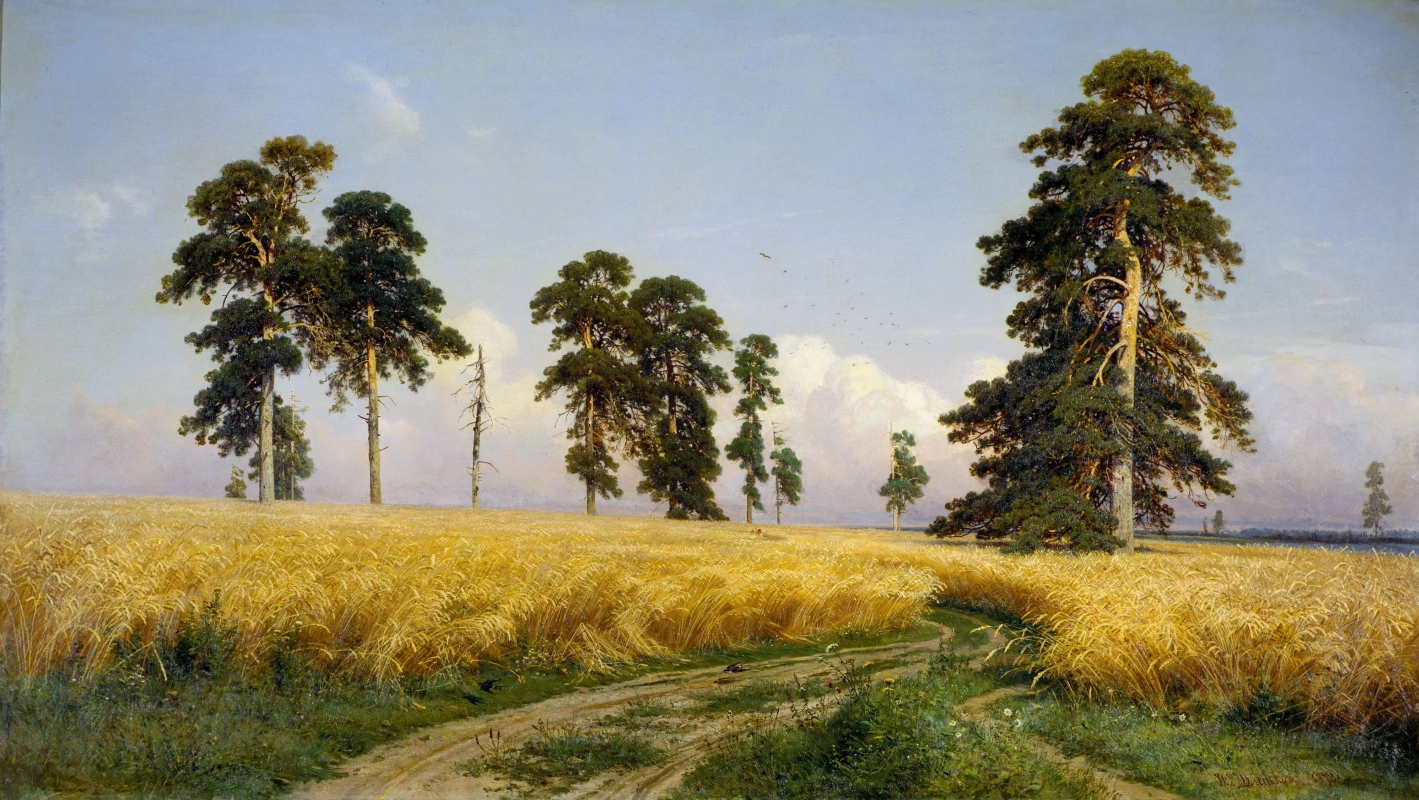log in
Enter site
Login to use Arthive functionality to the maximum
Rye
Ivan Shishkin • Painting, 1878, 107×187 cm


















Description of the artwork «Rye»
The public saw Shishkin’s Rye picture for the first time in the year of its creation at the 6th travelling exhibition. In his letter to Repin, Ivan Kramskoy discussed the exhibited works and said: “I will speak in the order (in my opinion) the things are ranged at the exhibition according to their inner dignity. The first place is taken by Shishkin’s Rye”. The painting was inspired by the artist’s homeland, Yelabuga. Several pencil sketches have survived, one of them has a mark that clearly informs us “what the artist wanted to say”: “Expanse, much space, land. Rye. God’s grace. Russian wealth”. We can see a typically Russian landscape designed to reflect these states.
The road is a popular motive among Russian artists (1, 2). In the interpretation of Shishkin, the country path winding among the endless rye field acquires such power and monumentality that it becomes one of the symbols of Russian life in general. The tonality of the picture is light calm, restrained. It seems, looking at her, you can hear the tunes of folk songs.
The land is filled with heat, a dry hot wind is felt, waves rolling over the ears of golden rye and clouds covering the sky point to it. All this creates a presentiment of a thunderstorm, which will possibly break out in the nearest future.
The pines, so loved by Shishkin, are the structural component of the landscape. Their trunks are graceful and monumental, like an antique colonnade. Swifts fluttering above the path bring the landscape to life. Barely visible in the distance, the heads of walking people, firstly, demonstrate the immensity of the vastness (people seem tiny), secondly, they connect the landscape and man, claiming that we face not just a view of nature, but a story about the Russian life — in this particular case, it is not denouncing, but rather blissful, with an intonation of admiration. Looking more closely, as usual, we find Shishkin’s scrupulousness in depicting every single blade of grass, every stalk and drop.
If we consider the picture in the context of social and artistic tendencies, then by the end of the 1870s it became clear that the Wanderers would not do much on accusations alone. There was a need for some kind of positive ideals, and the landscape perfectly filled this gap. Shishkin’s road in this picture is not a road of sorrow (as, for example, Levitan’s Vladimirka). There is no longing or hopelessness in it, it is not a dead end. The mood of the picture is rather thanksgiving to life, enjoying the boundless space, admiring the ascent of the spirit. This is a bright road.
Noon in the Neighbourhood of Moscow can be considered the forerunner of this picture. The same theme is already outlined here: the breadth of endless expanses, the joy of a simple life, illuminated by light and sun. However, we will not find idealizations in Shishkin’s art, he remains the greatest realist. This is not an idealization, but a look at Russian reality from an unusual joyful angle.
Written by Aliona Grosheva
The road is a popular motive among Russian artists (1, 2). In the interpretation of Shishkin, the country path winding among the endless rye field acquires such power and monumentality that it becomes one of the symbols of Russian life in general. The tonality of the picture is light calm, restrained. It seems, looking at her, you can hear the tunes of folk songs.
The land is filled with heat, a dry hot wind is felt, waves rolling over the ears of golden rye and clouds covering the sky point to it. All this creates a presentiment of a thunderstorm, which will possibly break out in the nearest future.
The pines, so loved by Shishkin, are the structural component of the landscape. Their trunks are graceful and monumental, like an antique colonnade. Swifts fluttering above the path bring the landscape to life. Barely visible in the distance, the heads of walking people, firstly, demonstrate the immensity of the vastness (people seem tiny), secondly, they connect the landscape and man, claiming that we face not just a view of nature, but a story about the Russian life — in this particular case, it is not denouncing, but rather blissful, with an intonation of admiration. Looking more closely, as usual, we find Shishkin’s scrupulousness in depicting every single blade of grass, every stalk and drop.
If we consider the picture in the context of social and artistic tendencies, then by the end of the 1870s it became clear that the Wanderers would not do much on accusations alone. There was a need for some kind of positive ideals, and the landscape perfectly filled this gap. Shishkin’s road in this picture is not a road of sorrow (as, for example, Levitan’s Vladimirka). There is no longing or hopelessness in it, it is not a dead end. The mood of the picture is rather thanksgiving to life, enjoying the boundless space, admiring the ascent of the spirit. This is a bright road.
Noon in the Neighbourhood of Moscow can be considered the forerunner of this picture. The same theme is already outlined here: the breadth of endless expanses, the joy of a simple life, illuminated by light and sun. However, we will not find idealizations in Shishkin’s art, he remains the greatest realist. This is not an idealization, but a look at Russian reality from an unusual joyful angle.
Written by Aliona Grosheva


